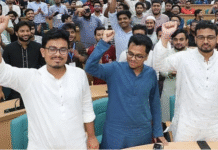Expanding social protection
What are the challenges for a developing country like ours?

Though country experiences vary, social protection in general covers policies and programmes designed to reduce poverty and vulnerability through labour market interventions for the efficient functioning of labour markets, interventions related to social insurance to reduce people’s exposure to risks, and social assistance interventions to enhance people’s capacity to manage economic and social vulnerabilities, such as unemployment, exclusion, sickness, disability and old age. Also, strengthening of the social protection systems is aimed to promote women’s empowerment and gender equality. The 2030 Agenda for Sustainable Development sets a clear vision for action to expand coverage of social protection systems and measures for all, with a view to eradicating poverty and reducing inequality, including gender inequality.
What is the economics of social protection? In my view, the economics of social protection involves three major aspects: (i) what proportion of the Gross Domestic Product (GDP) the government is spending on social protection; (ii) the approaches of social protection; and (iii) financing social protection.
On the first aspect, recent data on public social protection expenditure as a share of GDP (for the latest available years) for 173 countries suggest that while most of the developed economies spend quite a high proportion of their GDPs on social protection (15-30 percent), a large number of developing countries spend very low on social protection. Bangladesh is placed at the bottom of the list of countries with a share as low as only 1.6 percent. It is important to mention here that with very low spending on social protection, many of the SDGs are highly likely to be left unrealised in Bangladesh.
On the second aspect, there are debates concerning the approaches of social protection, whether social protection should be universal or targeted. While universal approach argues for social protection for each person, critics claim that universalism is not cost-effective and unfairly distorts individual efforts, and, therefore, targeting should be a better solution. Also, there are debates on whether net income should be considered while determining a needy population, or the capabilities approach should be undertaken as income is misrepresented and, in many occasions, fails to unearth the root causes of poverty. Furthermore, there are debates over the means of social protection, whether cash transfer is better than programmes based on transfers in kind.
Finally, a major aspect related to the approaches of social protection is the growing acceptance of undertaking a lifecycle perspective, which helps to understand the impacts of demographic change on countries. With the change in the structure of the population over time, the policy attention and allocation of public resources to address lifecycle risks and challenges should also change.
The third aspect is related to financing social protection. Many developing countries face a critical challenge in mobilising resources for social protection programmes. The tax-GDP ratio is very low in many developing countries. For example, Bangladesh has a tax-GDP ratio of less than 10 percent. With a very low tax-GDP ratio, governments in many developing countries face fiscal constraints in expanding social protection programmes. Concerning raising tax revenue, governments also face the challenge of expanding the tax base and taxing those who have the capacities in paying taxes but evade paying.
As countries develop, ideally, for generating government’s revenue, the reliance on indirect taxes should decline while that on direct taxes should increase. It is a common feature in many developing countries that a large number of potential taxpayers, which include many ultra-rich people, remain outside of the tax-net or pay a negligible amount of taxes.
Also, many economic sectors, capable of paying taxes, are either fully exempted from paying taxes or enjoy the privileges of paying a substantially reduced amount of taxes. It should also be highlighted that governments in many developing countries suffer from the usual problem of not getting their priorities right. Therefore, while governments allocate resources for many “low-priority” activities (from the view-point of development perspective), the resources left for social protection remain very inadequate.
Dr Selim Raihan is Professor, Department of Economics, University of Dhaka, Bangladesh, and Executive Director, South Asian Network on Economic Modeling (SANEM). Email: selim.raihan@econdu.ac.bd









